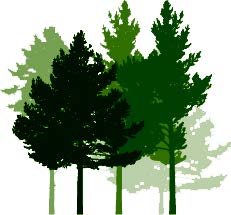Search technical reports
Molecular deformation of wood and cellulose studied by near infrared and Raman spectroscopy
By Fei Guo, March 2019.
Download SWP-T071 (pdf)
Executive summary
Eucalyptus can be alternative plantation species to radiata pine for New Zealand. One major problem preventing eucalyptus wood from high-value uses is its high growth-stress level, which causes problems in solid wood processing. Current methods to measure growth-strain are destructive and time-consuming. Growth-stress in wood, like mechanical stress, can cause deformation on the molecular level, which can be detected using spectroscopy. The overreaching objective of this thesis was to investigate the possibility of a non-destructive and rapid spectroscopy-based method to measure strain in wood. The molecular deformation caused by stress or strain was studied in detail using near infrared (NIR) and Raman spectroscopy.
Chapter 1 provides background and a literature review. In Chapter 2, the suitability of Eucalyptus globoidea for veneer and LVL production was investigated in relation to growth- strain levels. Veneer recovery, veneer splitting and wood properties were evaluated and correlated with growth-strain. Veneers with no, or limited, defects can be obtained from E. globoidea. Veneer recovery (54.5%) correlated with growth-strain and was highly variable between logs, ranging from 23.6% to 74.5%. There was a moderate positive association between splitting length and growth-strain (r = 0.73), but no significant association with wood stiffness. Growth-strain reduced veneer recovery by splitting, and was largely independent of stiffness, suggesting the possibility of finding trees with both low growth-strain and high stiffness, desirable for structural wood products. The considerable variation in growth-strain and stiffness indicated a possibility for genetic improvement. The unfavourable effects of growth-strain highlighted the demand for a rapid and non-destructive method to evaluate growth-strain levels in wood.
Chapter 3 describes experiments aimed at better understanding the effects of molecular deformation of wood and cellulose on NIR spectra. Dry wood and paper samples were stretched to different strain levels using a purpose-built tensile test device fitted into an NIR spectrometer while collecting transmission spectra. Consistent spectral changes caused by mechanical strain, assigned to OH stretching bands, were observed for all sample types.Bands at 6286 ± 5 cm−1 and 6470 ± 10 cm−1 were tentatively assigned to the OH groups connected with the 2OH···6O and 3OH···5O intramolecular hydrogen bonds of crystallinecellulose Iβ, respectively. Both bands shifted to higher wavenumbers, indicating theelongation of the hydrogen bonds. A linear relationship was found between band shifts and mechanical strain. Band shift rates for the 3OH bond were more than twice that of the 2OH bond, consistent with bending of the glycosidic bond. Bending tests showed that the band ataround 6286 cm−1 shifted in opposite direction when under tension or compression. Chapter 4 summarises the roles of water-accessible and -inaccessible cellulose in the load transfer of wood using deuterium exchange combined with NIR spectroscopy. The spectral changes on NIR spectra caused by mechanical strain could be highlighted by averaging the loading and unloading cycles to compensate for effects of desorption and isotope re- exchange due to environmental fluctuations. After deuteration, the bands affected by mechanical strain at around 6420, 6240 and 4670 cm−1, which had been assigned tohydroxyl groups in cellulose, remained at these positions, suggesting that the inaccessible cellulose fraction was the main load-bearing component in wood. A small band at around4700 cm−1 responding to mechanical strain was only visible in the deuterated spectra, indicating that accessible hydroxyls also contributed to the load transfer. Furthermore, the measurements confirmed previous reports of moisture adsorption of wood under tensile stress.
Chapter 5 investigated the possibility of measuring growth-strain non-destructively using NIR spectroscopy. This requires the measurement of water-saturated samples by reflection NIR. Results showed that abundant free water in rewetted and never-dried green samples overlapped with the band of interest and weakened the structural information of crystalline cellulose in the NIR spectra; reflection NIR spectra were shown to be of lower quality than transmission spectra. Despite the weak signal for rewetted and green samples, the 6286cm−1 band shifted linearly to higher frequencies with the increase in tensile strain, in bothtransmission and reflection NIR spectra, because of the elongation of hydrogen bonds in cellulose. Further, NIR band-shift rates were lower for never-dried green samples than for those previously dried, suggesting differences in macroscopic and molecular strain. Lastly, growth-strains of 163 green wood samples were measured destructively using strain gauges and correlated to previously collected NIR spectra. No correlation was found, however, between growth-strain of green stems as measured by strain gauges and the NIR spectra in reflection mode. Challenges included excessive signal overlap at high moisture content, lower signal-to-noise ratio of diffuse reflection compared with transmission NIR spectroscopy, and variations in growth-strain.
In Chapter 6, Raman spectroscopy was examined for its potential to measure growth-strain non-destructively, as the spectra are unaffected by water. A partial least squares model built from the Raman spectra could predict tensile strain with a root mean square error of 427.5με, in a dataset with growth-strain ranging from −135 με to 4780 με. Apart from the widely reported band shift at 1095 cm−1 upon mechanical strain, spectral changes at 1420, 1120,895, 456 cm−1 were identified. These bands might be attributed to the molecular deformation of cellulose. The band shift rates during tensile tests were −3.06 and −2.15 cm−1/% for rewetted and green wood, respectively. As for the NIR measurements, the difference in the Raman band shift rates indicated that less macroscopic strain was transferred into molecular strain for green wood than previously dried wood. This indicated irreversible molecular changes in the wood cell walls upon air-drying below fibre saturation point. Further, Raman spectra were collected from the wood surface of 18 green eucalypt stems before measuring growth-strain. A moderate correlation was found between growth- strain measured with strain gauges and the 1095 cm−1 band position. Raman spectroscopycould be used to non-destructively estimate growth-strain with moderate accuracy, but was negatively affected by the inhomogeneity of wood, instrumental instability, and fluorescence effects.

 Specialty Timbers New Zealand
Specialty Timbers New Zealand
No posts yet
Add a post